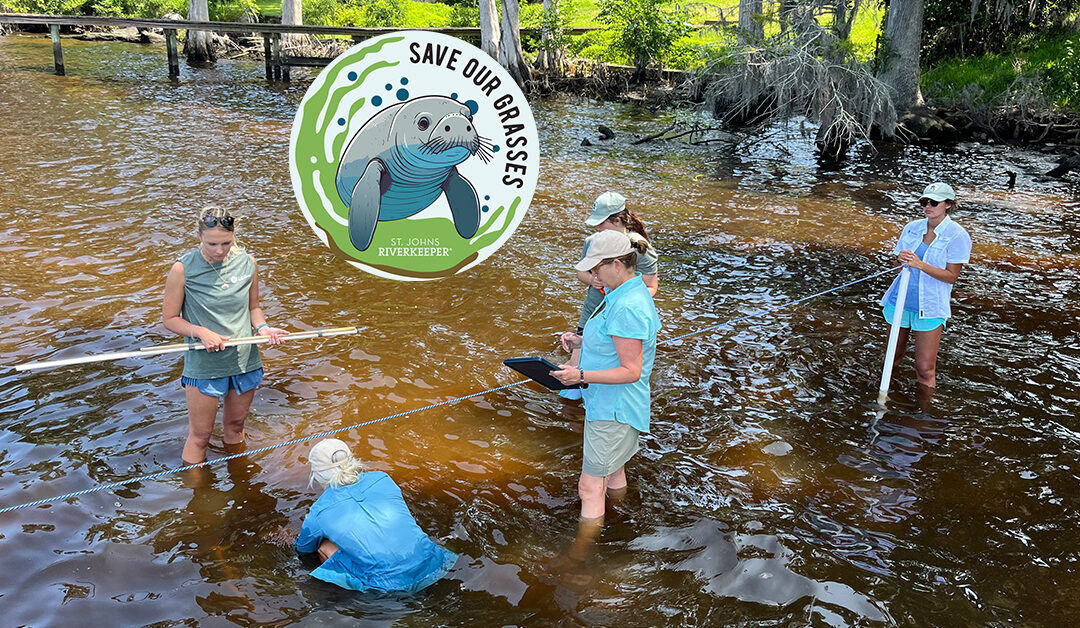If you’ve been following along on our journey to SAVe Our River’s Grasses for the past year, you know that submerged aquatic vegetation (SAV) is the foundation of our river’s health. That is why St. Johns RIVERKEEPER (SJRK) has pledged to search for answers and implement solutions to improve the health of our grasses and our river over the course of this five-year Expedition.
Sadly, we have experienced a significant decline in SAV in the St. Johns River in recent years. However, we are starting to see signs of recovery. The SJRK team returned to the river for its first trip of the 2024 SAVe Our River’s Grasses Expedition to continue our campaign to restore the struggling SAV of the St. Johns.
Our latest field visit aboard our patrol boat, the Kingfisher, brought us from Doctor’s Lake in Clay County to Lake George in Putnam County. We have strategically chosen each location to continually visit throughout the five years of this expedition so that we can collect meaningful data over time to help us find science-based solutions to help the St. Johns SAV thrive once more. Learn more about SAV.
May 2024 Findings
Over four days, our team surveyed an 80-mile stretch of the river searching for remaining grass beds, taking measurements, testing water quality, and seeking solutions to restore this vital habitat. Here is a summary of our findings:
- SJRK is pleased to report that every monitoring site along the 80-mile expedition route had submerged aquatic vegetation (SAV).
- At several sites, grass lengths were observed to be longer than they were in 2023, and there appeared to be an improvement in canopy heights.
- This year, the team discovered a greater diversity of grasses, encountering species not observed in 2023. Newly encountered species include: Najas guadalupensis, Potamogeton pusillus, and Eleocharis sp.
- Chara sp., an SAV that is actually a macroalgae, was still dominant at the Welaka and Georgetown sites. It was also discovered further north in East Palatka. Chara is considered to be a precursor species to eelgrass and other SAV species.
- One of the most exciting highlights was the presence of long, healthy grasses within the temporary enclosures at Dancy Point and San Mateo that are part of the Florida Fish and Wildlife (FWC) agency pilot project. FWC has been installing temporary fencing to protect grasses from grazing wildlife, giving our river’s SAV a fighting chance. Once the grass beds are reestablished, the enclosures will be removed. Outside the Dancy Point enclosure, SAV was cropped like all the other unprotected areas, demonstrating the significant grazing pressure that makes it difficult for grass beds to grow and thrive.
In support of the FWC initiative, SJRK is collaborating with homeowners and bass anglers to install additional enclosures along our Expedition route. Permitting for this project is currently in progress, and more details will be provided soon.
This important work to save our grasses would not be possible without the support of our partners and friends, including our donors, riverfront residents, advising scientists, community leaders, anglers, and river enthusiasts of all kinds.
May 2024 Field Log Coming Soon
SJRK will share a 2024 Overview document and a May 2024 Field Log with our detailed findings soon. Stay tuned and follow along on Instagram, Facebook and LinkedIn for updates! You can also sign up for our monthly newsletter to stay informed about this and other river issues and opportunities to Get Your Feet Wet with us along the St. Johns River watershed.
Support the Expedition
Each of our SAVe Our River’s Grasses field visits costs up to $15,000 for staffing, water quality testing, lodging, fuel, equipment, and supplies.
Please consider a gift to help support our SAV research and advocacy efforts so we can continue this vital work to protect some of the most threatened habitat in our watershed.
Support the Expedition
